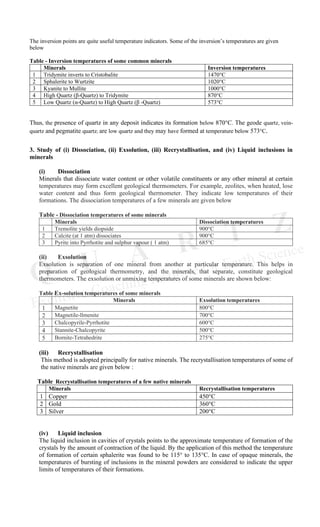Geological Thermometers
- 1. The composition of mineralising solutions, temperature and pressure are the three essential factors which play important role in mineral deposition. The formation of mineral deposits takes place by precipitation from the mineralising solutions. The composition of mineralising solutions determines the nature of mineral deposits. The increase in temperature enhances the solubility of materials in solution, while its decrease causes precipitation from aqueous solutions or magmas. The less soluble salts are precipitated first, followed by more soluble ores. The sequence of minerals in a mineral deposit or mineral zoning may be explained by above. The pressure is another factor which plays important role in mineral deposition. In general, the decrease in pressure causes precipitation, while its increase promotes solubility. The gases are comparatively more sensitive to pressure variations, like carbon dioxide held in water under pressure increases solubility of calcium carbonates. GEOLOGICAL THERMOMETERS DEFINITION AND CLASSIFICATION Proper understanding of origin of mineral deposits and their classification requires the knowledge of formation-temperatures of these deposits. Certain minerals, present over there, give information’s with regard to temperatures of their formations and of the enclosing deposits and they are known as geological thermometers. These geological thermometers may be classed chiefly into the following groups based on their preciseness: 1. The thermometers that record fairly accurately the specific temperature condition of formation of deposits. 2. The thermometers that provide an upper or a lower temperature, above or below which the deposits do not form 3. The thermometers that provide a range of temperature within which the deposits form; and 4. The thermometers that serve as rough indications of temperatures of formation of mineral deposits. The presence of two or more of less precise geological thermometers in a deposit narrows the range of temperature of formation for the deposits METHODS FOR PREPARATION OF GEOLOGICAL THERMOMETRY The geological thermometry may be prepared by several methods, the details of which are given below: 1. Direct Measurement This includes direct measurement of temperatures of lavas, fumaroles, hot springs etc. where formations of minerals take place. According to Bowen the earliest minerals of basic rocks, in general, form between 870°c and 600°c, decreasing with increase in silica content. High temperature ore mineral (pyrogenic mineral) like chromite forms within the range of magma consolidation. The surface temperature of Puga hot springs, Ladakh is measured upto 85°C, and as such sulphur, borax and potash which occur there, may have formed at temperatures above 85°C. Presence of native sulphur occurrence in the northern face of the younger cone of the Barren Island Volcano with measured surface temperature of 85°C indicates its temperature of formation to be much above 85°C. 2. Determination of Melting Points and Inversion Points of Minerals The melting points of minerals indicate the upper limits of temperatures at which they can form. For example the melting point of galena is known to be 1120°C. This implies that the galena of Hesatu - Belbathan belt, Bihar may have formed at temperature below 1120°C. The presence- of other ingredients associated with the mineral further lowers the (belting point and, thereby, the temperature of its formation. The melting points of some common minerals are given below: Table Melting temperatures of some common minerals Minerals Melting Temperature Minerals Melting Temperature 1 Olivine 1890°c 5 Antimony 630°c 2 Anorthite 1550°c 6 Stibnite 546°c 3 Diopside 1391°c 7 Bismuth 271°c 4 Albite 1120°c 8 Sulphur 119°c GL-Aug-2019 Economic Geology Q U A R T Z – E C I E S Nikhil V. Sherekar M.Sc. Geology 8390377801 (SET+PET+CSIR-UGC-NET-JRF AIR-28) Geological Thermometers
- 2. The inversion points are quite useful temperature indicators. Some of the inversion’s temperatures are given below Table - Inversion temperatures of some common minerals Minerals Inversion temperatures 1 Tridymite inverts to Cristobalite 1470°C 2 Sphalerite to Wurtzite 1020°C 3 Kyanite to Mullite 1000°C 4 High Quartz (β-Quartz) to Tridymite 870°C 5 Low Quartz (α-Quartz) to High Quartz (β -Quartz) 573°C Thus, the presence of quartz in any deposit indicates its formation below 870°C. The geode quartz, vein- quartz and pegmatite, quartz; are low quartz and they may have formed at temperature below 573°C. 3. Study of (i) Dissociation, (ii) Exsolution, (iii) Recrystallisation, and (iv) Liquid inclusions in minerals (i) Dissociation Minerals that dissociate water content or other volatile constituents or any other mineral at certain temperatures may form excellent geological thermometers. For example, zeolites, when heated, lose water content and thus form geological thermometer. They indicate low temperatures of their formations. The dissociation temperatures of a few minerals are given below Table - Dissociation temperatures of some minerals Minerals Dissociation temperatures 1 Tremolite yields diopside 900°C 2 Calcite (at 1 atm) dissociates 900°C 3 Pyrite into Pyrrhotite and sulphur vapour ( 1 atm) 685°C (ii) Exsolution Exsolution is separation of one mineral from another at particular temperature. This helps in preparation of geological thermometry, and the minerals, that separate, constitute geological thermometers. The exsolution or unmixing temperatures of some minerals are shown below: Table Ex-solution temperatures of some minerals Minerals Exsolution temperatures 1 Magnetite 800°C 2 Magnetile-llmenite 700°C 3 Chalcopyrile-Pyrrhotite 600°C 4 Stannite-Chalcopyrite 500°C 5 Bornite-Tetrahedrite 275°C (iii) Recrystallisation This method is adopted principally for native minerals. The recrystallisation temperatures of some of the native minerals are given below : Table Recrystallisation temperatures of a few native minerals Minerals Recrystallisation temperatures 1 Copper 450°C 2 Gold 360°C 3 Silver 200°C (iv) Liquid inclusion The liquid inclusion in cavities of crystals points to the approximate temperature of formation of the crystals by the amount of contraction of the liquid. By the application of this method the temperature of formation of certain sphalerite was found to be 115° to 135°C. In case of opaque minerals, the temperatures of bursting of inclusions in the mineral powders are considered to indicate the upper limits of temperatures of their formations.


